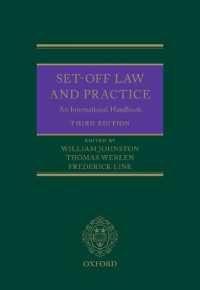- ホーム
- > 洋書
- > 英文書
- > Science / Mathematics
Full Description
The world's leading student text on physical volcanology offers an unmatched introduction to the field
In the revised second edition of Fundamentals of Physical Volcanology, the authors provide a comprehensive introduction to the processes that control when and how volcanoes erupt. Understanding these processes involves bringing together ideas from a number of disciplines, including branches of geology, such as petrology and geochemistry, and aspects of physics, such as fluid dynamics and thermodynamics.
With the help of new and improved illustrations, this new edition explains eruption types and mechanisms, subsurface processes, volcanic eruption products, and how volcanoes affect their surrounding environment.
Readers will also find:
Quantitative treatment of physical volcanological processes
A review of the historical development of volcanology
Examples of current research trends and topics in volcanology
Perfect for undergraduate earth sciences students and graduate students starting research programs in volcanology, Fundamentals of Physical Volcanology will also earn a place in the libraries of researchers in related fields seeking an accessible introduction to the principles of physical volcanology.
Contents
Preface xiii
Acknowledgments xv
Glossary xvii
1 Volcanic Systems 1
1.1 Introduction 1
1.2 Styles of Volcanic Eruptions 1
1.2.1 Effusive Eruptions 2
1.2.2 Hawaiian-Style Eruptions 3
1.2.3 Flood Basalt Eruptions 4
1.2.4 Plinian Eruptions 5
1.2.5 Ignimbrite-Forming Eruptions 6
1.2.6 Strombolian Eruptions 7
1.2.7 Vulcanian Eruptions 9
1.2.8 Hydromagmatic Eruptions 10
1.2.8.1 Deep Marine Environments 10
1.2.8.2 Lava Flows Entering Water 10
1.2.8.3 Shallow Marine and Crater Lake Eruptions 11
1.2.8.4 Subglacial Eruptions 12
1.2.8.5 Interactions with Groundwater 13
1.2.9 Diatreme-Forming Eruptions 13
1.3 Volcanic Systems 14
1.4 The Structure and Aims of This Book 16
1.5 Further Reading 16
1.6 Questions to Think About 17
2 Magma Generation and Segregation 19
2.1 Introduction 19
2.2 Rock-Melting Mechanisms 19
2.3 Volcanism and Plate Tectonics 20
2.3.1 Tectonic Settings, Melting Processes, and Magma Composition 23
2.3.1.1 Mid-Ocean Ridges and Oceanic Intraplate Settings 23
2.3.1.2 Continental Intraplate Settings 25
2.3.1.3 Subduction Zones - Island Arcs and Continental Arcs 25
2.4 Melting and Melt Segregation in the Mantle 27
2.4.1 Nature of the Mantle 27
2.4.2 Onset of Mantle Melting 28
2.4.3 Melt Migration 29
2.5 Summary 31
2.6 Further Reading 31
2.7 Questions to Think About 32
3 Magma Migration 33
3.1 Introduction 33
3.2 Diapiric rise of Melt 33
3.3 The Change From Diapir Rise to Dike Formation 34
3.4 Dike Propagation 35
3.5 Trapping of Dikes 37
3.6 Consequences of Dike Trapping 41
3.7 Summary 42
3.8 Further Reading 44
3.9 Questions to Think About 44
4 Magma Storage 45
4.1 Introduction 45
4.2 Evidence for Magma Storage Within the Crust 45
4.2.1 Structural Evidence Provided by Calderas 45
4.2.2 Petrological Evidence in Lava Flows 46
4.2.3 Geophysical Evidence 48
4.2.3.1 Seismic Techniques 48
4.2.3.2 Gravity and Magnetotelluric Techniques 49
4.2.3.3 Deformation Techniques 51
4.2.4 Geological Evidence From Exposed Intrusions 53
4.3 Formation and Growth of Magma Reservoirs 55
4.4 Magma Reservoirs and Their Impact on Volcanic Systems 62
4.4.1 Fractionation in Magma Reservoirs 62
4.4.2 Regulation of Eruption Frequency and Magnitude 63
4.4.3 Volatiles and Chamber Failure 65
4.5 Summary 66
4.6 Further Reading 67
4.7 Questions to Think About 67
5 The Role of Volatiles 69
5.1 Introduction 69
5.2 Volatiles in Magma 69
5.3 The Solubility of Volatiles in Magma 70
5.4 Bubble Nucleation 73
5.5 Bubble Growth 74
5.5.1 Growth by Diffusion 74
5.5.2 Growth by Decompression 74
5.5.3 Bubble Coalescence 75
5.6 Influence of Volatiles on Magma Dynamics 78
5.7 Magma Fragmentation and the Influence of Volatiles on Eruption Styles 79
5.8 Summary 81
5.9 Further Reading 82
5.10 Questions to Think About 82
6 Steady Explosive Eruptions 83
6.1 Introduction 83
6.2 Influence of Gas Bubbles Prior to Magma Fragmentation 83
6.3 Acceleration of the Gas-Magma Mixture 84
6.4 Controls on Exit Velocity 86
6.4.1 Magmatic Gas Content and Exit Velocity 86
6.4.2 Dike Shape, Vent Geometry, and Exit Velocity 87
6.5 Eruption Plumes in Steady Eruptions 88
6.5.1 Plume Rise 89
6.5.2 Controls on Plume Height 91
6.6 Fallout of Clasts from Eruption Plumes 91
6.6.1 Rise of Clasts in an Eruption Plume 91
6.6.2 Fallout of Clasts from Eruption Plumes 93
6.7 Unstable Eruption Columns 93
6.7.1 Plume Density and Column Stability 94
6.7.2 Causes of Column Instability 94
6.8 Summary 96
6.9 Further Reading 97
6.10 Questions to Think About 98
7 Transient Volcanic Eruptions 99
7.1 Introduction 99
7.2 Magmatic Explosions 99
7.2.1 Modeling Transient Magmatic Explosions 100
7.2.1.1 Relating Vent Pressures to Eruption Velocities 100
7.2.1.2 Predicting the Range of Ballistic Clasts 102
7.2.1.3 Plume Heights in Transient Eruptions 105
7.3 Transient Eruptions Involving External Water 106
7.3.1 Types of Hydromagmatic Eruptions 106
7.3.2 Mechanisms of Violent Magma-Water Interactions 108
7.3.3 Tephra from Hydromagmatic Eruptions 108
7.4 Summary 108
7.5 Further Reading 109
7.6 Questions to Think About 109
8 Pyroclastic Falls and Pyroclastic Density Currents 111
8.1 Introduction 111
8.2 Fallout of Clasts from Eruption Columns 111
8.2.1 Fallout from the Rising Eruption Column 111
8.2.2 Fallout from the Umbrella Region 113
8.2.3 Fall Speeds of Pyroclasts 113
8.2.4 Other Factors Affecting Fallout from Eruption Columns 115
8.2.5 Common Features of Fall Deposits 116
8.3 The Application of Eruption Column Models 117
8.3.1 Analyzing a Fall Deposit 117
8.3.2 Estimating the Eruption Rate and the Eruption Speed 118
8.3.3 Finding the Wind Speed 120
8.3.4 Finding the Fall Deposit Volume and the Eruption Duration 121
8.3.5 Fall Deposits: Summary 121
8.4 Pyroclastic Density Currents and Their Deposits 122
8.4.1 Origins of Pyroclastic Density Currents 122
8.4.1.1 Column Collapse and Pyroclastic Fountaining 122
8.4.1.2 Directed Blasts and Collapses from Lava Domes and Flows 123
8.4.2 Pyroclastic Density Current Emplacement Processes 124
8.4.3 Nature of the Deposits 128
8.5 Summary 129
8.6 Further Reading 130
8.7 Questions to Think About 131
9 Lava Flows 133
9.1 Introduction 133
9.2 Origin of Lava Flows 133
9.3 Types of Lava Flows 133
9.4 Lava Flow Rheology 138
9.5 Rheological Control of Lava Flow Geometry 140
9.6 Lava Flow Motion 143
9.7 Lengths of Lava Flows 144
9.8 Surface Textures of Lava Flows 145
9.9 Effects of Ground Slope and Lava Viscosity 149
9.10 Summary 149
9.11 Further Reading 151
9.12 Questions to Think About 151
10 Eruption Styles, Scales, and Frequencies 153
10.1 Introduction 153
10.2 Chemical Composition and Styles of Volcanic Activity 153
10.3 Chemical Composition and Effusive Eruptions 155
10.3.1 Conditions of Effusive Eruption 155
10.3.2 Chemical Composition and Lava Flows 157
10.4 Chemical Composition and Explosive Eruptions 157
10.4.1 Transient and Sustained Explosive Activity 157
10.4.2 Chemical Composition and Transient Explosive Activity 158
10.4.3 Chemical Composition and Sustained Explosive Eruptions 160
10.4.3.1 Role of Viscosity 160
10.4.3.2 Role of Gas Content 161
10.5 Summary of Compositional Controls on Eruption Character 161
10.6 Magnitudes and Frequencies of Volcanic Eruptions 163
10.6.1 The Magnitude of Historic Volcanic Eruptions 163
10.6.2 The Magnitude of Volcanic Eruptions in the Geological Record 166
10.6.3 The Frequency of Volcanic Eruptions 167
10.6.4 Magma Reservoirs and Eruption Magnitude and Frequency 167
10.7 Elastic and Inelastic Eruptions and the Contribution of "Mush" 168
10.8 Eruptions of Exceptional Magnitude 171
10.8.1 Introduction 171
10.8.2 Large Ignimbrite-Forming Eruptions 171
10.8.3 Flood Basalt Eruptions 171
10.9 Summary 172
10.10 Further Reading 173
10.11 Questions to Think About 174
11 Volcanic Hazards and Volcano Monitoring 175
11.1 Introduction 175
11.2 Types of Volcanic Hazards 175
11.2.1 Lava Flows 175
11.2.2 Pyroclastic Falls 176
11.2.3 Ash in the Atmosphere 178
11.2.4 Pyroclastic Density Currents and Surges 179
11.2.5 Lahars 180
11.2.6 Jökulhlaups 181
11.2.7 Volcanic Gases 182
11.3 Hazard Assessment 183
11.4 Monitoring Volcanoes and Short-term Eruption Prediction 185
11.5 Hazard Mitigation 188
11.6 Summary 189
11.7 Further Reading 189
11.8 Questions to Think About 190
12 Volcanoes and Climate 191
12.1 Introduction 191
12.2 Evidence for the Impact of Volcanic Eruptions on Climate 191
12.3 Satellite Monitoring of Climate Change After Volcanic Eruptions 194
12.4 The Effects of Volcanic Eruptions on Climate 195
12.4.1 The Influence of Plume Height on Climate Change 196
12.4.2 The Effect of Geographical Location on Climate Impact 196
12.4.3 The Effects of Eruption Volume on Climate Impact 196
12.4.4 The Effects of Magma Composition on Climate Impact 198
12.4.5 The Effects of Eruption Duration on Climate Impact 198
12.5 Volcanoes and Mass Extinctions 199
12.6 Summary 200
12.7 Further Reading 201
12.8 Questions to Think About 201
13 Volcanism on Other Planets 203
13.1 Introduction 203
13.2 Volcanically Active Bodies in the Solar System 203
13.3 The Effects of Environmental Conditions on Volcanic Processes 206
13.4 The Moon 208
13.5 Mars 212
13.6 Venus 216
13.7 Mercury 218
13.8 Io 220
13.9 Europa 222
13.10 Differentiated Asteroids 223
13.11 Summary 224
13.12 Further Reading 224
13.13 Questions to Think About 224
Answers to Questions 225
Index 231








